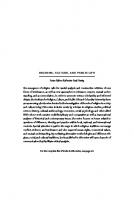Afterimage: Film, Trauma and the Holocaust [1 ed.] 9781439903957, 9781592132089
The appearance of Alain Resnais' 1955 French documentary "Night anda Fog" heralded the beginning of a new
133 71 35MB
English Pages 230 Year 2003
Recommend Papers
![Afterimage: Film, Trauma and the Holocaust [1 ed.]
9781439903957, 9781592132089](https://ebin.pub/img/200x200/afterimage-film-trauma-and-the-holocaust-1nbsped-9781439903957-9781592132089.jpg)
- Author / Uploaded
- Joshua Hirsch
File loading please wait...
Citation preview
Afterimage Film, Trauma, and the Holocaust
Copyrighted Material
In the series EMERGING MEDIA: HISTORY, THEORY, NARRATIVE
edited by Daniel Bernardi
Copyrighted Material
AfteriInage Film, Trauma, and the Holocaust
JOSHUA HIRSCH
TEMPLE UNIVERSITY PRESS
Philadelphia Copyrighted Material
Temple University Press, Philadelphia 19122 Copyright © 2004 by Temple University All rights reserved Published 2004 Printed in the United States of America @Ibe paper used in this publication meets the requirements of the American National Standard for Information Sciences-Permanence of Paper for Printed Library Materials, ANSI Z39.48-1984 Library of Congress Cataloging-in-Publication Data Hirsch, Joshua Francis, 1962Afterimage: film, trauma, and the Holocaust I Joshua Hirsch. p. em. - (Emerging media: history, theory, narrative) Includes bibliographical references and index. ISBN 1-59213-208-1 (cloth: alk. paper) - ISBN 1-59213-209-X (pbk. : alk. paper) 1. Holocaust, Jewish (1939-1945), in motion pictures. 2. War films-History and criticism. I. Title. II. Series. PN1995.9.H53H572004 791.43'658--dc21 2 4
6
8
9
753
2003053131 1
Copyrighted Material
To Eva, Ferencz, Imre, and Laszl6 Hirsch and to Sophia and Isaac Horwitz-Hirsch
Copyrighted Material
Copyrighted Material
Contents
Preface
ix
Acknowledgments
xv
1
Introduction to Film, Trauma, and the Holocaust
2
Night and Fog and the Origins of Posttraumatic Cinema
28
3
Shoah and the Posttraumatic Documentary after Cinema Verite
63
4
The Pawnbroker and the Posttraumatic Flashback
85
5
Istvan Szabo and Posttraumatic Autobiography
111
6
Postmodernism, the Second Generation, and Cross-Cultural Posttraumatic Cinema
140
Notes
163
Works Cited
193
Index
205
Copyrighted Material
1
vii
Copyrighted Material
Preface
IF SCHOLARSHIP can never be wholly objective, writing about the Holocaust presents the historian with a limit case of scholarly implication. One of the effects of the trauma constituted by genocide and concentration camps is that it continues to thrust upon those who encounter it in the present the subjectivities assumed by or forced upon the participants in the events of the past. What reference to the Holocaust is not marked by an identification with the position of victim, perpetrator, collaborator, bystander, resister, or one of the many shades in between? My own identification with the victim position must have begun earlier than I can remember. In 1944, at the age of sixteen, my father was deported with his family from Hungary to Auschwitz. When he was liberated at Buchenwald in 1945, only one cousin remained from his extended family. No photograph remains to show that my grandparents, my uncle, and all the rest had ever existed. Their images existed only in my father's decaying memory. In fact, it was a struggle for him just to call up an image of his mother 'S face, and even then it was often the image of a photograph of her that he carried through the selection line at Auschwitz, and that a guard finally knocked from his hand. For me, these absent images received a substitution from Night and Fog, which I was shown at my synagogue as a child. The image from that film of a bulldozer pushing a pile of emaciated bodies into a mass grave became the most vivid icon with which I visualized the Holocaust. I pictured the corpses and thought, "Jews, what we are." Preparing a paper on Night and Fog for a graduate seminar, I watched the film again on videotape. When the bulldozer scene appeared, I watched it over and over, trying to repress my feelings of horror in order to record the details. In my memory of seeing the film as a child, the bulldozer was a weapon driven by a Nazi. Viewing the film again, I realized the scene was shot after the liberation, and the bulldozer was probably driven by an Allied soldier. In any case, the driver never appears in frame . Copyrighted Material
ix
x Preface
This book began not with a theory or argument about what might be called-but uncomfortably-"Holocaust films," but with a series of encounters with individual films that seemed to articulate in one way or another a paradox that felt familiar to me: the paradox of trying to visualize and narrate a trauma that could not be captured in an image; of trying to remember an absence; of trying to represent the unrepresentable. I suppose the process of trying to understand these films is, among other things, my attempt to work through a set of childhood experiences that might be profitably condensed as that first viewing of
Night and Fog. What was it, what is it, about these films that leads one to try to understand them better? In Night and Fog, it was not only the shock of bulldozed corpses-the shock of the visible-but also the vague sense of a present haunted by something invisible, something only suggested by a ceaselessly moving camera, or a man's voice speaking a language I did not understand, but with a tone that nevertheless conveyed not the kind of alienating authority one had come to expect from traditional historical documentaries, but instead what Fran









